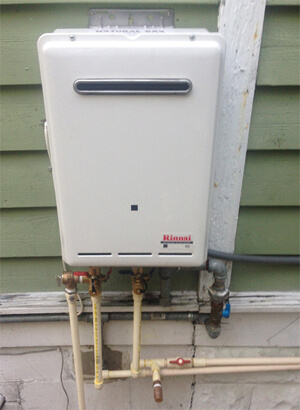Tankless Water Heaters

There is perhaps no more appropriately named plumbing fixture in the whole world than the tankless water heater. No deception, no confusion: It’s a water heater that has no hot-water storage tank. So, where does the hot water come from? Good question!
Tankless water heaters, while relatively new, are growing in popularity with both plumbing contractors and homeowners. These compact units are designed to provide hot water for the entire house—not just a single faucet—and are often called instantaneous, continuous-flow, or on-demand water heaters. Before getting into the specifics of tankless water heaters, let’s first take a look at standard water heaters.
Storage-Tank Water Heaters
Most homes have a standard water heater, which consists of a large cylindrical storage tank. Cold water is piped into the tank and electrical elements, or a gas-fired burner located inside the tank heats the water. An electronic thermostat allows you to control the water temperature. The heated water is stored in the tank until someone turns on a hot-water faucet or shower, or runs the dishwasher. Then, hot water is pumped out of the tank and through the home’s hot-water supply pipes.
Tank-style water heaters are popular because they’re affordable, readily available from several manufacturers, quick and easy to install, and available in a wide range of sizes. However, they do have a few drawbacks.
First, as mentioned earlier, hot water is stored in the tank. When the water temperature cools slightly, the heater kicks on to warm the water back to the pre-set temperature. That means the heater is working—and burning energy—regardless of whether you’re using hot water.
Also, because there’s a storage tank, that means there’s a limited supply of hot water available at any one time. So, while modern tank-style heaters do an adequate job of keeping up with demand most of the time, if there are multiple hot-water users at the same time (such as someone taking a shower while the dishwasher or washing machine is running), then the heater will struggle to supply enough hot water.
Another drawback is that the large storage tank takes up quite a bit of space. That might not be a problem in a spacious basement, but it’s often difficult to squeeze one into a utility closet, laundry room, or crowded garage.
Tankless Water Heaters
Tankless water heaters have a few distinct advantages over standard water heaters, but before discussing those benefits, let’s take a look at how a tankless water heater works.
First, a tankless water heater sits idle until a hot-water tap is opened in the house. Then, cold water is drawn into the unit and a flow sensor activates an electric heating element or gas-fired burner, which warms an internal heat exchanger. As the cold water passes over the heat exchanger, it’s warmed to the pre-set temperature. The hot water then exits the heater and travels directly to the faucet or appliance—not to a storage tank. Combustion gases, which are produced by gas-fired units, are exhausted through a dedicated, sealed vent pipe.

This compact, gas-fired tankless unit measures just 14 inches wide x 26 inches tall,
yet it produces 199,999 BTU of heat and 9.5 gallons of hot water per minute.
When the hot-water tap is turned off, the water heater shuts down. Therein lies the beauty of the tankless water heater: Since there’s no storage tank to keep filled with hot water, tankless models only heat water when it’s called for. As a result, tankless water heaters are much more energy-efficient than standard water heaters. According to the U.S. Department of Energy, the average household, which uses approximately 40 gallons of hot water per day, may consume up to 34% less energy than a home that relies on a standard water heater.
For even greater energy efficiency, consider the condensing tankless water heater. These premium units extract heat from the combustion gases and then use it to help heat the water. As a result, condensing heaters operate with an efficiency rating between 90 and 98%, as opposed to non-condensing tankless units, which operate at a still-impressive 80% or so.
Finally, because there’s no storage tank, tankless water heaters provide an unlimited supply of hot water, which is a real bonus for families with teenagers who routinely take 30-minute showers!
Here are a few other advantages of tankless water heaters:
- They’re designed to be space-saving and compact. They can even be hung on a wall.
- Multiple tankless units can be installed in larger homes.
- They have low operating costs.
- There is no storage tank to maintain.
- There are no standby heat losses, as is common with tank-style heaters.
- They allow for precise and consistent water-temperature control.
- Tankless heaters have a service life of up to 20 years, which is nearly twice as long as standard water heaters.
- Some tankless models can be installed outdoors, simplifying the venting of combustion gases.
It should be noted that tankless water heaters require greater upfront costs. They’re more expensive, on average, than standard water heaters, and it also costs more to have one installed. They’re also typically costlier to repair. But despite these issues, a tankless water heater is simply the smartest, most energy-efficient way to produce domestic hot water for most households.